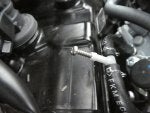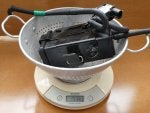1. Remove the LH side fairing to gain access.
2. Pull the vapor supply line off at the fuel tank end.
3. Unclip the connector for the power supply to the purge valve solenoid:
![]()
4. Remove the purge line at the three-way joiner where it splits into two lines before connecting to the throttle bodies:
![]()
5. Block off the exposed line with a screw or such like.
![]()
6.Remove the two bolts that attach the canister cradle to the frame.
![]()
7. Remove the whole system.
![]()
2. Pull the vapor supply line off at the fuel tank end.
3. Unclip the connector for the power supply to the purge valve solenoid:

4. Remove the purge line at the three-way joiner where it splits into two lines before connecting to the throttle bodies:

5. Block off the exposed line with a screw or such like.

6.Remove the two bolts that attach the canister cradle to the frame.

7. Remove the whole system.







